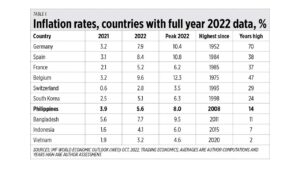The Philippine Statistics Authority (PSA) reported that the December 2022 inflation rate was 8.1%. It is the peak rate for 2022 and also the highest since 2008.
As of today, only a few countries in the top 50 largest economies in the world have reported their December 2022 inflation data. In Table 1, I list five countries each in Europe and Asia. Europe has been severely affected mainly because of high energy prices. Germany, the largest economy in Europe and fourth largest in the world, experienced its highest inflation in 70 years. Switzerland, which has the lowest inflation in Europe, still experienced 29-years high price increases.
It seems that the series of interest rate hikes by central banks and the monetary authorities of many governments have succeeded in causing demand destruction, where consumers were forced to cut down their spending on many items, which pulled down overall inflation rates in the latter months of 2022.
In the Philippines, price hikes in transportation — oil, fares, vehicle rentals, etc. — were the main contributor to overall high inflation in 2022. It was the reverse in 2019 where transport was a major contributor — only 1% — to low inflation that year (See Table 2).
The important policy implication here is that taxes and costs that contribute to high oil and transport prices must decline, or at least remain stable and not increased further. High oil taxes and costs mean high operating cost for tractors, harvesters, trucks, and irrigation pumps. Which in turn leads to high food prices.
Bienvenido S. Oplas, Jr. is the president of Bienvenido Oplas, Jr. Research Consultancy Services, and Minimal Government Thinkers. minimalgovernment@gmail.com.
